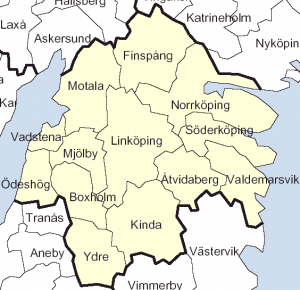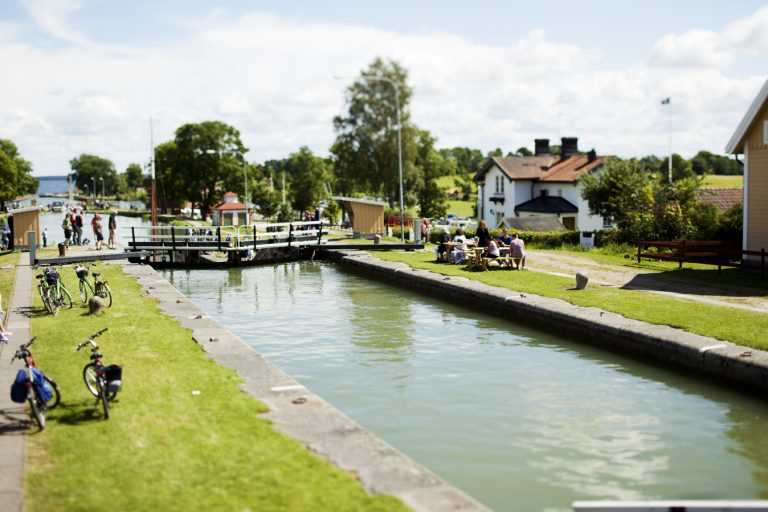Population (2001): 411 372 Area: 10 562 km2

Östergötland County comprises 13 municipalities: Boxholm, Finspáng, Kinda, Linköping, Mjölby, Motala, Norrköping, Söderköping, Vadstena, Valdermarsvik, Ydre, Átvidaberg and Odeshög. It corresponds mainly to the old province of Ostergötland but also contains small parts of Smáland and Södermanland, plus an uninhabited part of Narke. The county town and also one of Sweden’s oldest bishop’s seats is Linköping, with a population of about 86,000.
Landscape and environment
 The central part of the county is the intensively cultivated Ostgöta plain, spreading in a 30-50 km broad belt between Lake Vattern and the Baltic. The western part is mainly open, cultivated land whose limestone bedrock is covered with some of the very best arable soils in Sweden. By Lake Vattern the forest-clad rock of Omberg provides panoramic views across both the lake and the plain. The eastern part of the Ostgöta plain is an undulating district of deciduous woods that becomes an archipelago along the coast. In the north the plain is broken by a more than 100 metrehigh fault overlooking the northern forest and valley landscape. Below this fault lie a number of large lakes: Boren, Roxen and Gian. South of the plain the land rises slowly towards the southern forest district, which gradually becomes the South Swedish Highlands, with height differences of up to 100 m and peaks of more than 300m above sea level. Crossing faults are filled with long, narrow lakes such as Sommen.
The central part of the county is the intensively cultivated Ostgöta plain, spreading in a 30-50 km broad belt between Lake Vattern and the Baltic. The western part is mainly open, cultivated land whose limestone bedrock is covered with some of the very best arable soils in Sweden. By Lake Vattern the forest-clad rock of Omberg provides panoramic views across both the lake and the plain. The eastern part of the Ostgöta plain is an undulating district of deciduous woods that becomes an archipelago along the coast. In the north the plain is broken by a more than 100 metrehigh fault overlooking the northern forest and valley landscape. Below this fault lie a number of large lakes: Boren, Roxen and Gian. South of the plain the land rises slowly towards the southern forest district, which gradually becomes the South Swedish Highlands, with height differences of up to 100 m and peaks of more than 300m above sea level. Crossing faults are filled with long, narrow lakes such as Sommen.
There are great sand deposits on the plain, at Mjölby, for example, which are the deposits of a long-lasting, stationary glacier edge when the inland ice was melting. Lake Vattern drains into the Baltic across the plain via Motala Ström and numerous lakes. Near the mouth of the river, at Norrköping, waterfalls have provided a source of energy for early industrialisation.
The plain has a favourable climate compared with the hilly forest districts. On the southern slopes of Omberg, among the deciduous forests on the plain, there is one of the northernmost beech woods in Sweden. One of the major nature resources on the plain is Lake Tákern, which has become one of the country’s foremost bird sanctuaries since it was partly drained.
The chalky soils of the plain resist acidification, but there has been serious acidification damage in the northern forest district. Intensive farming on the plain has led to nutritive-salt pollution of the ground water and rivers. Discharges of various kinds have decreased greatly as a result of legislation and environmental measures.
Industry and commerce
The fertile Ostgöta plain has been one of the most important and richest in Sweden ever since prehistoric times. There are many palaces and manor-houses here. The plain’s surplus production encouraged Hanseatic merchants to settle in Söderköping and Skan-ninge. Vadstena acted as the market for the corn trade with Bergslagen in central Sweden. Grain cultivation is important: barley, autumn wheat and oil plants. Agriculture was mechanised here earlier than in other parts of Sweden and had the most “modern” farms in the country.
Consequently the number of people employed in agriculture and forestry is not more than three per cent. For the surviving farms in the forest districts milk is the most important product, but many small farms have disappeared in recent years.
The metal industry dates back to the iron mills of the 17th century and the war industry in the north with Finspáng as its traditional centre. Copper has been mined in the south since the Middle Ages.
The dream of building an inland waterway between the Baltic and the North Sea was realised in the early 19th century as the Göta Canal, which follows the river Motala Ström through part of Ostergötland. Motala Engineering Works was established in 1822 to service the canal and became a pioneer of the heavy engineering industry in Sweden. Not only technical equipment for the canal but also steamships, locomotives and heavy machinery were later built here.
With its roots in the 17th century a many-faceted textile industry grew up in Norrköping, which became one of Sweden’s most important industrial towns and a centre of the wool industry. After the textile industry had closed down in the mid-20th century and Holmen’s big paper mill in the centre of town on the river had moved out, Norrköping’s industrial district became “The Industrial Landscape’, a unique cultural monument in Sweden which includes the Museum of Work.

Modern industrial developments
are centred in Linköping, where SAAB-Scania builds aeroplanes and high-tech research work is carried out. In addition, Ericsson and FFV Aerotech have factories in Linköping, Whirlpool in Norrköping and Electrolux and Nokia in Motala. Two of Sweden’s largest pulp and paper mills in the MoDo Group are in Norrköping. Finspáng and Boxholm are old metal industry towns and there are several large food industries in Linköping.
 While the old industrial town of Norrköping was hard hit by modern industrial developments, Linköping was able to grow strongly thanks to high-tech industry and the expansion of a university established in the 1960s with technical, medical and liberal arts faculties. It now has some 15,000 students. As a cathedral city Linköping already had one of the country’s oldest high schools and a large diocesan library. Both Norrköping and Linköping benefited from the relocation of government offices from Stockholm in the 1970s; the Swedish Meteorological and Hydrological Institute has moved to Norrköping.
While the old industrial town of Norrköping was hard hit by modern industrial developments, Linköping was able to grow strongly thanks to high-tech industry and the expansion of a university established in the 1960s with technical, medical and liberal arts faculties. It now has some 15,000 students. As a cathedral city Linköping already had one of the country’s oldest high schools and a large diocesan library. Both Norrköping and Linköping benefited from the relocation of government offices from Stockholm in the 1970s; the Swedish Meteorological and Hydrological Institute has moved to Norrköping.
Linköping University has a research profile of its own, being organised on a thematic, interdisciplinary basis. The professors for each theme represent various basic subjects. Medical and nursing training also developed its own profile as a “health university”.
Ostergötland County is traversed by Sweden’s most important routes: European Highways 4 and 22 and
the main Stockholm-Malmö railway line with connections to Mjölby-Hallsberg and Linköping-Kalmar. Norrköping is one of the largest freight ports in the country. The airports at Linköping and Norr-köping handle both domestic and international flights. The Göta Canal, on the other hand, lost its commercial importance shortly after it was opened in 1832. It is now a lively tourist waterway.
Culture, tourism and recreation
The Ostgöta plain is richly endowed with relics from its very long history. One of the most remarkable from the Stone Age is the large lakedwelling at Omberg, whose wooden pole and floor construction has been preserved in Dagsmosse. Rock carvings from the Bronze Age, most of them round Norrköping, are among the richest in the country. The early Iron Age is represented by a large number of prehistoric hill forts and extensive remains of stone-wall enclosures that bear witness to a well-developed agricultural system. Rune stones have survived from the late Iron Age, among which the Rök Stone south of Lake Tákern with its long and partly deciphered inscription connected with ancient poetry and the Ledberg Stone west of Linköping with images from ancient Nordic mythology are unique monuments.
In Ostergötland as in Vastergötland, the two earliest Christianised old Swedish provinces, cathedral building had started in the 12th century and a large number of Romanesque parish churches had already been built. Linköping Cathedral, whose long period of building is reflected in a transition from Romanesque to Gothic in the middle of the nave and whose chancel vault is dated 1499, is the best preserved cathedral in its original form in Sweden. Next to the cathedral stands Linköping Castle with its roots in the Middle Ages, when it was a bishops seat. The Cistercian monasteries at Vreta and Alvastra were founded by royal decree and the mendicant orders established themselves in the
oldest towns, Söderköping and Skanninge. The main convent of the Brigittines at Vadstena achieved a special position as the greatest place of pilgrimage in Sweden and one of the country’s largest land-owners. It was built on an old royal estate by Birgitta Birgersdotter, Saint Birgit, who was canonised by the Pope a few years after her death in Rome in 1373. Her shrine is in the convent chapel. The ruins of Alvastra Monastery, Vreta Abbey and above all Vadstena Convent, which were all confiscated by the State at the Reformation, are important historical monuments today, attracting many visitors. Once again pilgrimages go to Vadstena and the Birgitta Order has a
convent in the town. Other great attractions in the late medieval town of Vadstena are the only town hall preserved from the Middle Ages and the best preserved example of the great 16th-century State castles. Stone was taken from Alvastra Monastery to build this castle. At the entrance to the rich Ostgöta plain from the Baltic the Crown had already built a permanent fort, Stegeborg, in the Middle Ages, the ruins of which still stand.
Medevi Spa is an attraction of another kind in the forest district on the boundary of Örebro County. This resort has wooden spa buildings from the 18th and 19th centuries and is still a centre for health care, recreation and tourism.
International contacts
The towns on the Ostgöta plain were already at the time of the German Hanseatic League part of an international economic system. The industrial developments of the 17th century, driven not least by the war economy, were led by merchants and experts from the Netherlands, who also controlled much of Sweden’s export trade. The great name in the industrial history of Norrköping and the northern forest district is Louis de Geer, who was brought to Sweden by King Gustaf II Adolf (Gustavus Adolphus). With its high-tech industries like SAAB-Scania and its modern university Linköping has developed contacts all over the world.


